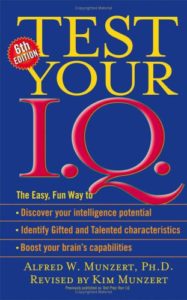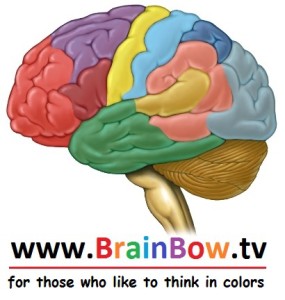In this article I will focus only on one published test.
I have the third edition of this book Test Your I.Q. by Alfred W. Munzert, Ph.D. (Prentice Hall, 1994).
Its new editions are available into the mass market. It’s PDF is available here (click on the cover):
IDIOTS v. IDIOTMETERS
Should “Idiots” File a Malpractice Class Action against IQ-test Designers?
© Edip Yuksel, J.D.
www.19.org
2 April 2004
Should lawyers file a class action against psychologists for malpractice on behalf of all those who took flawed IQ tests and discovered that they were idiots? Could they make a successful “faulty design” argument and establish mental pain and suffering, loss of self esteem, and loss of confidence in their mental activity? If they could, I bet there are millions of Americans out there eager to take their revenge, including those who were matched by MENSA with partners presumably sharing comparable IQs and then ending up with shared nightmares and divorce. I bet that the IQ Tests have contributed to sales of the Complete Idiot’s Guide or Incomplete Imbecile’s Guide (is coming soon!) series by convincing millions that they are indeed Idiots and Imbeciles.
I do believe that IQ tests measure some intellectual capabilities of individuals, sure with reasonable margins of error. But, out of curiosity, I have checked several IQ tests and found them riddled with flawed questions. I am not writing this criticism because I got low scores. To the contrary, I have received very high scores on each test I have taken so far (even my zealous religious opponents have conceded my high IQ in their books and articles). Furthermore, I do not claim that it is easy or even possible to design a flawless IQ test, and I am not dreaming or suggesting to design a test to test the test makers either. But I believe that many IQ tests on the market could be improved easily, if only the test designers had subjected them to trials and considered the results. Or they simply could have handed them to lawyers for cross-examination! Even if a lawyer who does not obtain good score on an IQ test, he or she is professionally skilled to smell flaws as long as it is presented as the evidence of an opposing party. (I am not practicing law, but I still feel a duty towards my comrades; they always need clients, especially psychologist ones!).
In this article I will focus only on one published test. I have the third edition of this book Test Your I.Q. by Alfred W. Munzert, Ph.D. (Prentice Hall, 1994). Its new editions are available into the mass market, and it is one of the most popular IQ Test books. The book contains great essays on intelligence; however its 60-question test is tainted with at least NINE flawed questions. This is more than enough to “reduce” an average person to a slow learner or to an idiot. Here are the flawed questions, followed by my criticism:
Question 2:
Which of the five is least like the other four?
- a) Nickel
- b) Tin
- c) Steel
- d) Iron
- e) Copper
According to the book the correct answer is C, that is, STEEL since “others are simple metals; steel is an alloy.” BUT this question measures the knowledge of metals and alloys rather than the IQ of the test taker. Those like me whose native language is not English may suffer additional disadvantage.
Question 6:
Which of the five is least like the other four?
- a) Dictionary
- b) Biography
- c) Atlas
- d) Almanac
- e) Directory
According to the book the correct answer is B, that is, BIOGRAPHY, since “all others are reference books. A biography is a narrative.” BUT another distinction could be made for ATLAS, since it is the only one which is the collection of maps while others are not.
Question 16:
Anne received $.59 change from a supermarket purchase. Of the eleven coins she received in change, three were exactly alike. These three coins had to be:
- a) Pennies
- b) Nickels
- c) Dimes
- d) Quarters
- e) Half dollars
According to the book the correct answer is B, that is, NICKELS, since “four dimes, three nickels, and four pennies is the only solution”. BUT the phrase “three were exactly alike” is ambiguous and justifies another answer too. The phrase should have been “only three were exactly alike.” Otherwise, PENNIES too could be the correct answer since in case of nine pennies ad two quarters, three pennies are exactly alike.
Question 19:
Which of the five makes the best comparison? Love is to hate as valor is to:
- a) Courage
- b) Security
- c) Cowardice
- d) Anger
- e) Terror
According to the book the correct answer is C, that is, COWARDICE, since “love is the opposite of hate. Valor is opposite of cowardice”. BUT “valor” is not a commonly used word. Therefore, it measures the knowledge of lexicon rather than IQ, especially of non native English speakers.
Question 27:
Which of the five designs is least like the other four?
- a) X
- b) T
- c) N
- d) V
- e) L
According to the book the correct answer is C, that is, design N, since “all the others are made with two lines; N is made with three lines”. BUT the correct answer could be A too, that is, design X, since X is the only one where two straight lines cross each other.
Question 42:
Which of the five makes the best comparison? Pencil is to paper as eye is to:
- a) Eyeglasses
- b) Ear
- c) Book
- d) Hat
- e) Brush
According to the book the correct answer is C, that is, BOOK, since “a person uses a pencil for the purpose of writing; a person uses the eye for the purpose of reading.” BUT the pencil writes on the paper, while the eye sees the written words. Writing and seeing are different activities. The former influences the paper, but the latter does not. (Excluding Schrodinger’s cat and other quantum quirks). What about EAR as the correct answer? Both pencil and paper are made of wood; both eye and ear are made of living cells.
Question 46:
Which of the five designs is least like the other four?
According to the book the correct answer is B, since “all the others have an odd number of squares; B has an even number.” BUT the design in option E also could be the correct answer, since all except E have equal distances between their concentric squares.
Question 52:
Which letter does not belong in the following series?
B E H K M N Q T
According to the book the correct answer is M, since “the series is made up of every fourth letter of the alphabet, starting with B”. However, E could be, even a better option, since it is the only vowel.
Question 55:
Which of the five is least like the other four?
- a) >
- b) =
- c) +
- d) <
- e) ll
According to the book the correct answer is C, that is + sign, since “the others all show mathematical relationships. + is a mathematical operation.” BUT II (two vertically parallel lines) is not a commonly known symbol of mathematical relation. As mathematical symbol for parallel it measures advanced knowledge in mathematics.
***
So, dear reader, if you are dying to find a one-question I.Q. test, then I have it for you. Please answer my question below:
Look at a mirror; what do you see:
- a) An idiot
- b) A genius
- c) A curious person
- d) An attractive person
- e) The photons reflected from the mirror
If your answer is A, then you are correct. Congratulations; but try to keep it secret; others might be jealous of you.
If your answer is B, then you need a reality check. See Marilyn Vos Savant; she got 228 reportedly.
If your answer is C, then you should continue looking at mirrors, until you find something else.
If your answer is D, then every moment is working against you; look deeper.
If your answer is E, then you know too much physics but little neurology and no humor.
PS: I am looking forward receiving your homemade IQ tests. The interesting and original ones will be published here.




